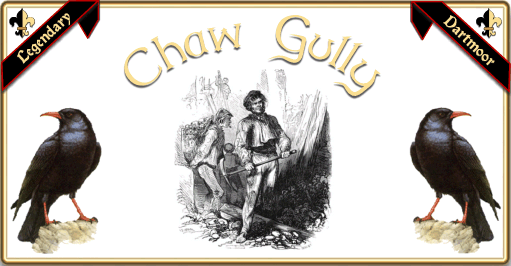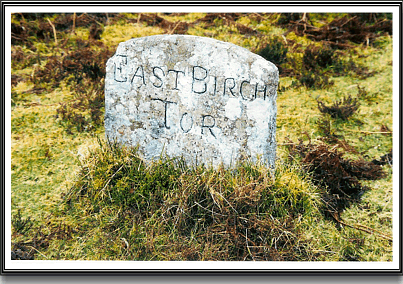
High up, near the Challacombe ridge is a deep gash in the moorside which is known as ‘Chaw Gully’. Some estimates go as far as to say it is at least fifty feet deep, either way it is the work of the ‘old men’ of the moor. It is here that they tore out the very heart of the moorland to get at the precious tin ore lying beneath. Ever since this act of vandalism the deep gully has always been a place of foreboding, the wind howls down through its deep scars and seldom does the sunlight warm the gert’s floor. The old tinners always shook their heads and shivered at the mention of ‘Chaw Gully’. The very ridge through which it was cut, Challacombe, is said to have meant the ‘Valley of Jawbones’. The name ‘Chaw’ comes from the Devonshire name for a Chough, which is just a local name for the Jackdaw. Never a fitting name could be given to this cursed place because it is here that the birds build their nests and sit like sentinels on its rocky sides. As soon as a human approaches they commence their incessant chattering and squawking and should any animal be unfortunate to slip over the steep gully’s sides their bones will be picked clean in days.

Chaw Gully – R. Burnard, 1894
Nobody knows why the malevolent spirits dwell in the deep, damp ferny depths of the gert. It has been suggested that the spirits of the ancients became incensed when the miners cut through one of their sacred stone avenues on the Challacombe Ridge. A branch of Chaw Gully known as ‘Lane’s Shaft Gully’ ends just below the ancient stone row. Or could it be that they guard some precious treasure? It has been a well known fact that the rich ore in this area also contained small amounts of gold and there is a tradition that at the bottom of a deep tinners shaft lies a hoard of gold. The mine has always been known to the tinners as the ‘Roman Mine’ and it is guarded by an ancient raven. Some say that this bird was the very raven that Noah sent from the ark never to return. The old bird perches on a high crag above the mine and acts as a sentry. Throughout the centuries many greedy men have perished in their quest to find the elusive treasure. On numerous occasions, intrepid miners have been lowered down into the dark, dank shaft. As soon as they started their ascent the old raven would croak and caw a warning from his lookout and those stood above would see a gnarled hand holding a knife appear. It would then slowly start cutting through the fibres of the rope until with a twang it would break and the unfortunate soul suspended below would be sent plummeting to his death. In the morning the broken remains of his body would be found laid out on the heather beside the shaft, the old raven looking menacingly down and the jackdaws cackling and cawing in amusement. These foul deeds are said to be the work of the ‘Dartmoor Knockers’, a race of goblins who dwell in the bowels of the moor. Sometimes, if it is a still night the sound of their knockings’ or hammerings can be heard as they hew out the precious ores. Occasionally on dark, misty nights the knockers emerge from the dark depths of the mines and wander the moor in search of new mineral bearing lodes, and unfortunate be the mortal that should meet them.
It would be remiss to label all of the knockers activities as evil, sometimes they will led the miners to rich lodes of ore by tapping the seams until the tinners reach them. Other times they will start frantically knocking to warn of some imminent danger such as a collapse. But if the mine has such friendly knockers then chunks of pasty must be left as a thank-you.

East Birch Tor Mine Boundstone.
Chaw Gully is where the boundaries of two tin mines met: the East Birch Tor Mine and the Vitifer Tin Mine. The gert (gully) is a deep surface working where the ore has been extracted. The East Birch Tor Mine was first recorded in 1836, in 1848 it became known as the East Birch Tor Mining Co., and in 1852 was known as the New Birch Tor and Vitifer Consols Tin Mining Co. Crossing, 1990, p.250, records that the mine was also known as the ‘Headland Tin Mine’, a fact confirmed by the 1888 Ordnance Survey Map. The boundstone found at the western end of the sett is the only known tinner’s boundstone that bears the full name of the mine, Brewer, 2002, p.276. The mine was served by a cross-cut adit some 287 fathoms long, this intersected six tin lodes. In 1848 further levels were driven west and east of the main south lode and were reported to be yielding tin throughout. In 1851 the mine was in financial difficulties and was finally abandoned. But it was soon reopened as an amalgamated mine, its partner being the nearby Devon Great Tin Croft. During the following years six shafts were sunk to a depth of 24 fathoms but once again these yielded disappointing results and work halted in 1867. In 1903 a new lease for the mine was obtained and this was worked on and off until 1926-7 when the mine finally closed, Hamilton Jenkin, 1974, pp. 103-4.

1888 O.S. map showing Chaw Gully.
The Vitifer Mine was first recorded in 1796 by the mineralologist, Charles Hatchett. He described the mine as having a lode running east to west for over a quarter of a mile. The tin lode varied in width from between one to twenty inches. Alongside the lode ran a thin vein of iron ore and this was mined on a different lease. Hatchett notes how at the time the mine was employing forty men who worked thirteen shafts. The Engine Shaft was 21 fathoms deep and had an over-shot wheel for pumping out the water. The Western Shaft was sunk to a depth of forty fathoms. In 1808 the Vitifer Mine was placed up for sale and by the 1820’s it was being worked in conjunction with Birch Tor Mine. In 1838 the Birch Tor Mine was reported to be the only mine of any magnitude working on Dartmoor. It employed 87 men and 30 women and children. The miners consisted mainly of a rough gang who had left other mining districts because of petty offences they had committed. It is said that their accommodation was so dire that the hovels they shared were never empty, as soon as a tinner got out of his bed another climbed straight into it. The work was described as hard and tortuous, the miners working above ground were constantly exposed to the cold harsh moorland weather. Those working underground were not much better off because due to the porous nature of the granite they frequently toiled beneath seeping streams of ice-cold water. In 1866 the mine, now called the New Birch Tor and Vitifer Consols, was reported as producing 95 tons of black tin which sold for £4,739. It employed one hundred and twenty people and was stated as being ‘profitable’. But by 1886 the mine was abandoned after several years of diminishing returns. In 1923 a new lease was obtained and a few of the shallow levels were re-opened but little tin was extracted. Further trials were carried out between 1938 and 1939 but the outbreak of the war saw the final abandonment and closure of the mine, Hamilton Jenkin, 1974, pp 103-5.
Bibliography.
Brewer, D. 2002 Dartmoor Boundary Markers, Halsgrove, Tiverton.
Crossing, W. 1990 Crossing’s Guide to Dartmoor, Peninsula Press, Newton Abbot.
Hamilton Jenkin, A.K. 1974 Mines of Devon, Volume 1, David & Charles, Newton Abbot.
 Legendary Dartmoor The many aspects past and present of Dartmoor
Legendary Dartmoor The many aspects past and present of Dartmoor
